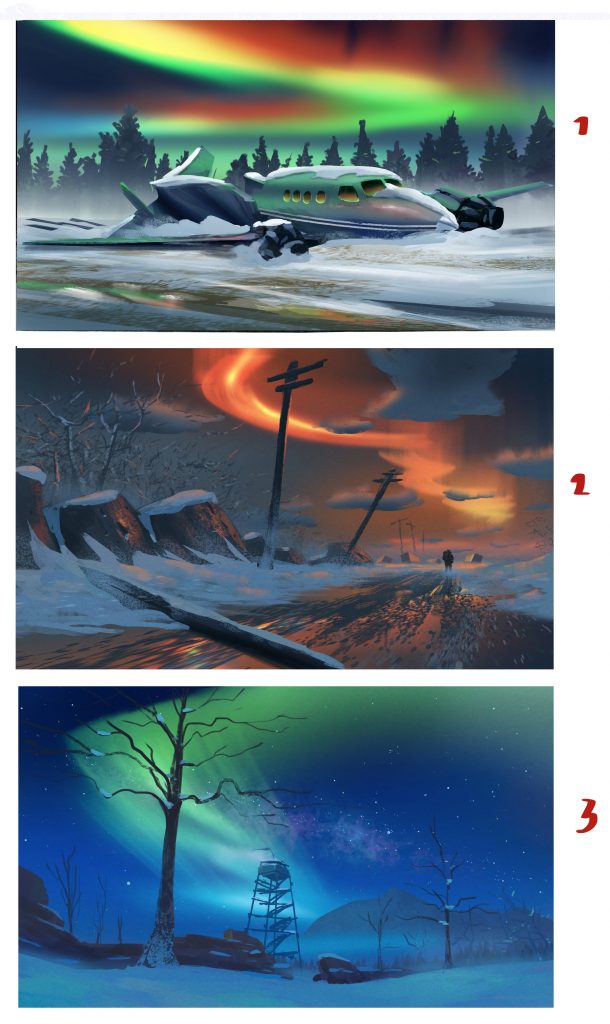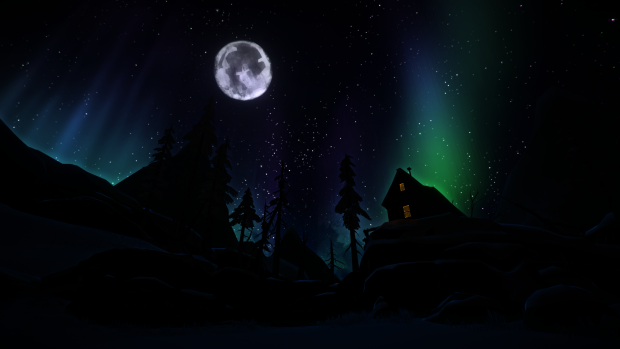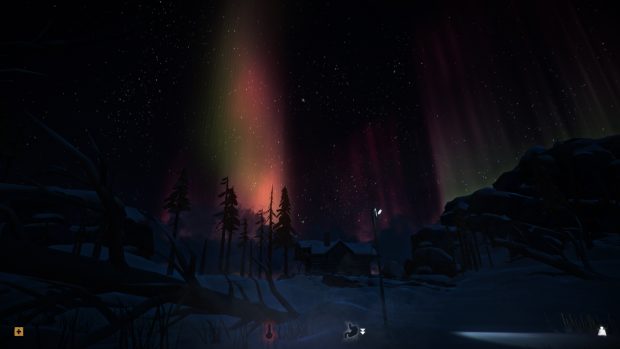State of the Art: The Long Dark's aurora
The eerie beauty of the aurora
The coloured lights flaring across the night sky in the frozen Canadian wilderness were one of the most anticipated elements of Hinterland's survival game, The Long Dark [official site]. Since the Kickstarter we've known they would do more than brighten the night, playing a key part in the game's episodic story mode, but now they're in the game I find myself braving the uptick in danger they bring or setting aside a necessary survival task to stand outside and stare up at the skies in delight. So how did the design of the aurora develop. how did the team balance beauty and hostility and DID YOU KNOW that the Aurora Borealis makes a noise in real life that Hinterland incorporated into the game?? Here's creative director Raphael van Lierop to explain more in our latest State of the Art feature!
As ever, you can click on any of the still images for a larger version, and I've added in a few of my own screenshots and gifs to further illustrate the experience!
Pip: I know that the aurora is a powerful force in The Long Dark and a key element of the story so I'm wary of spoilers but what can you tell me about the phenomena and its role in the game?
Raphael van Lierop: In The Long Dark, a mysterious geomagnetic disaster that takes the form of a brilliant flash of light in the sky renders all technology inert. It’s a thematic hook that we explore throughout our setting and game mechanics. The aurora is a visual metaphor for what we have lost, a reminder of the power of nature, and that we are ultimately insignificant in the world. It also teasingly brings some technology to life, with gameplay impacts that we’ve only started to hint at in Episode Two of Wintermute.
Pip: I'm interested in the aesthetic role of the aurora here - it injects a lot of colour and movement so did you have to balance that out with other elements onscreen being more static or more muted?
RvL: The "Majestic Aurora" are brilliant fire across the night sky - a sky that is otherwise typically quite dark, as you would expect in a world without many functioning artificial lights. They are playful and animated and are something of a companion during nighttime travels. They cast light of their own and scintillate with green, blue, purple, and pink hues. They only ever appear with a clear sky, and also tint the window lights when you are in interiors, so that if you wake up at night while the aurora is active you’ll feel its presence when inside - even if your shelter doesn’t have electric lights or television screens that may flicker ominously.
For the player, seeing them in the sky is a sign that new possibilities are open to you, as well as new threats. Since they only appear at night, and only with clear skies, the Aurorae don’t really conflict with any other weather elements like clouds or fog. Really, they just bring the night environment to life in a way that is hopefully unexpected and exciting for the player. Like many things in The Long Dark, we try to balance the beauty of the environment against its hostility.
Pip: I think (unless I've been spectacularly unlucky) the aurorae will only go into the game with the story mode*. I know that a lot of people are really excited about finally seeing them in the wild - some for story reasons, but also just because I think there's a fascination with the phenomenon. I was interested in how you see people's interest in aurorae and at what point you decided to make the lights such a significant element in the game?
RvL: The aurora is also present in the Sandbox, though it is rare. We’ve just re-tuned some of the probabilities in a patch that should be out shortly, to make them a bit more common for players. I’d like to see what we can do to play with the aurora as a type of weather that comes and goes more or less frequently, as a means to ensure the world feels more dynamic. As far as making them a significant element in the game, one of the earliest names for the game that became The Long Dark was "Borealis". People immediately associate the aurora with the Far North, and there have been numerous instances where aurora - which as an atmospheric phenomenon are tied to solar activity and disturbance of the Earth’s geomagnetic "shield" - interfered with various electronics systems, so really it was the perfect vehicle for so many of the game’s concepts.
Pip: The design of the aurora in the game seemed to first appear in screenshots as a stylised curl of light behind Trapper's Homestead. By the time the Wintermute trailer came out it had shifted to being long, bright shafts of light as you might see in real life. It would be great to know how the aurora's design changed over the course of development and how you fixed on its form.
RvL: We pretty much went straight from that old "whorl" design, to the more traditional "banners" that you see now. It was important to me that the Aurora had a real presence in the world - not just as an element of the skybox, but something that felt like it had a physical presence. The current design allows it to hang above you as you explore the world, shimmering and moving like a living thing. There’s an almost sentient, animalistic sense to how it moves. Like it’s watching. Waiting.
As we developed the style, we researched a lot of aurora videos and time-lapses to look at the shapes and colours you typically saw, and then did a lot of iteration on the colours, width, movement, etc. We also researched the sound the aurora makes - it has actually been recorded! So we took that sound and added more to it and came up with what I think is a unique, iconic sound, that is almost musical but has echoes of an almost electronic hum to it.
[I actually had a poke around for recordings of the sound aurorae make and found the following - you want the 1:30 timestamp for the sounds themselves! - Pip]
Pip: More generally, The Long Dark uses light and colour brilliantly to express particular types of weather and times of day. Can you tell me a bit about how you figured those systems out?
RvL: We have a real-time time of day lighting system so the first thing is making all the lighting work for clear weather at various times of day. We paid particular attention to the "shelf" hours around dawn and dusk, because the intention was that for players who wanted to derive all the information from the world (vs. relying on UI), they should be able to be able to get up from Rest, step out of a shelter, and immediately get a relative sense of the time of day. Getting dawn and dusk was important to that.
Then at noon the ground shadows are very short, sort of like they would be in real life, so again you can tell a bit about time of day just by looking at the lighting and shadows. We spent a lot of time on this lighting, played with bloom settings, the brightness of the white snow (to create a bit of a glare effect on very clear sunny days), the tint of the lighting, etc. There are a lot of different factors that went into making a clear day look good.
After that, we have night time, which we express using the starfield and the moon, which - like the sun - gradually crawls across the sky as night progresses. At various times we’ve played with the darkness of night, to try to recreate that sense you get if you’re ever out of the city at night. When I was growing up I lived on a farm out in the countryside, far from light pollution, and I remember standing out at night and seeing a black sky full of stars -- and endless blanket of them -- and then a kind of darkness that you seldom see anymore. And so I wanted to create that sense of total blackness, darkness so deep that you could hardly see your hand in front of you. But that proved difficult for nighttime navigation (and night is already tricky enough), so we brought back some ambient light to approximate how bright a winter’s sky can be when the air is so crisp and cold and you just see this brilliant white moon like a light bulb in the sky, and when your eyes adjust you can make out shadows and a loose definition of some things, and we recreated this sense in the game on clear nights. You can see just enough to get around without a light source (if you’re desperate) but not well enough to tell if that shape in the near distance is a tree stump or a wolf.
Our weather and time of day systems are really complex so we spent a lot of time trying to get them right. We have about 8 different kinds of weather and we also interpolate between them using a variety of presets, probability, and game logic to ensure they feel relatively random but also logical. Theoretically, players who have invested a lot of time in the game can start to learn to "read" the weather. It was really important to me that this be the case, because you can do this in real life - you can get a sense that the weather is changing and you can learn to read the sky and wind so that you know if you’ll have time to get to your cabin or if you’d better hunker down and start digging the snow shelter.
The blizzard was probably the most fun to create, because we knew we wanted it to feel like an event, like an angry thing that could kill you if you got stuck out in it. And it needed to also be disorienting. So the combination of background fog, the dense particles, the howling wind, and so on - it really works to confuse the player. I still get lost in blizzards in the game.
The wind is its whole own thing; also a complex system that blends a lot of wind sounds, accounts for speed, gusting, ambiences (so wind sounds different if you are high up in a clearing or down by the coastline with a rocky cliff behind you). Wind deserves its own article. I’m happiest with our most recent iteration on weather colour and lighting which we released in our Faithful Cartographer update, and then the Aurora with Wintermute. I love how some of the cloudy settings introduce a kind of almost "glow" to the ambient lighting and approximate that kind of low winter sun, and the fog distances frame trees in the distance so well.
We pushed back all our distant fog as well, so that players can pick out landmarks better. It’s one of the reasons we moved the Lookout Tower in Mystery Lake -- because by pushing the fog back, you can now stand up there and pick out landmarks you want to navigate to: the dam, the railway, the camp office, the clearing with Unnamed Pond, etc. We also did a lot of colour grading work to make all the various combinations of lighting and sky colour felt more cohesive. I think weather and lighting is one of the most important "characters" in the game. In The Long Dark it’s much more than backdrop - weather and time of day have significant gameplay implications for us, so I think of it as one of our purest marriages of art, technology, and player experience.
Pip: The Long Dark manages to communicate a very specific biting cold which I recognise from real life so I often forget the game is actually very stylised in terms of how it looks. I'd be interested to know how the look of The Long Dark came together and whether you experimented with more "realistic" graphics at any point?
RvL: We never chased realism in our art style. If anything we’ve tried to push away from it. You can see that in the last major UI overhaul we did in Faithful Cartographer. As with most UI updates, it wasn’t universally loved, but for me the old UI had too many visual elements that clashed with our stylization so what we have in the game now is more cohesive and true to the art direction.
For communicating the sense of cold, we have some effects like the breath you see on screen, which actually provide gameplay feedback - the colder it is outside, the more opaque the breath effect is - but I think audio does a lot of the heavy lifting in terms of making you feel cold. That crispness of the footsteps, the sound of cold nylon "crinkling" as you walk along, shivering vocalizations, etc. But in terms of the overall art direction, while we experimented with a variety of styles early in development, the goal has always been to create a beautifully stylized world that would stand on its own and produce iconic screenshots and gameplay videos.
Pip: The environments remind me a lot of Firewatch in that they tend to create lots of tempting screenshot opportunities. There are lovely vistas and trees which frame sightlines and so on. How did you balance that curation with keeping the sense of wilderness in there?
RvL: Firewatch is a beautiful game. I always feel I have to mention that we launched our sandbox well before them lest people think we copied their art style. I think they did an incredible job with the environment, and I think it helps that for them their player paths were much more clearly defined.
In terms of environment design, we try to use the natural landscape to invite exploration, or discourage it. Sometimes leaving a bit of a clearing between trees is enough to draw the player’s eye. Framing an opening with two slightly curved fallen trees can approximate an arch, which feels like something you should walk through. But really the ideal is that the player finds their own way through exploration.
I think with our snow covering, every route tends to feel traversable unless it has a very obvious boundary, so it’ll be interesting to see how our art style adapts to non-winter settings in the future, and how we need to adapt our world-building process to ensure players can still find their way around with some freedom but also the right kind of breadcrumbing with landmarks - both natural and human-made - so they don’t feel perpetually lost. For The Long Dark, gaining a familiarity with the environment such that you can get to where you want to go as efficiently as possible is the kind of mastery needed to keep you alive.
Pip: Thank you for your time!
For more State of the Art features and beautiful game art just head over to the State of the Art tag page and browse the full list!
*This question was from before the game launched, but the answer might still be of interest if you haven't happened upon the lights in the sandbox.






























